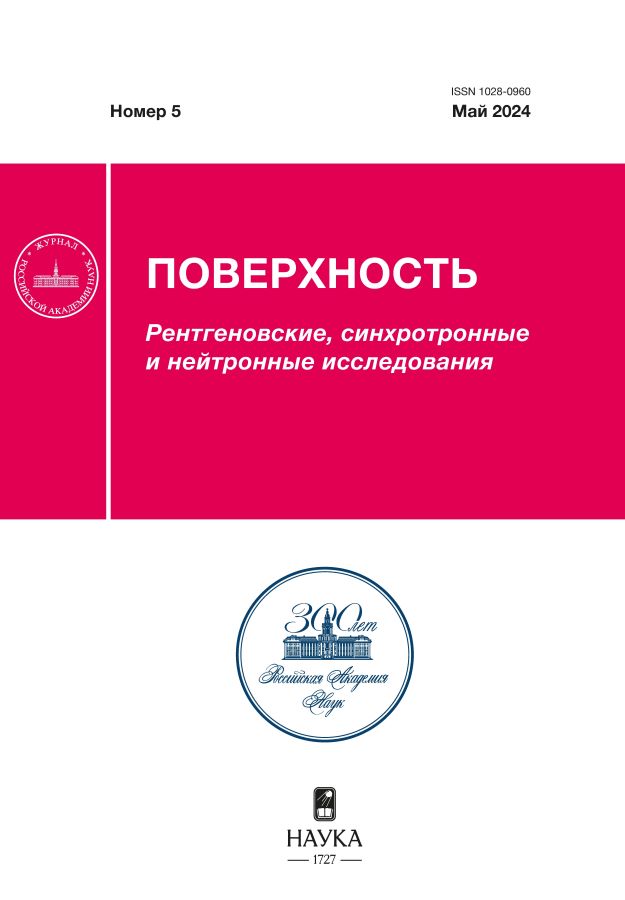Modification and Sputtering of Inhomogeneous Multilayer Oxidized Metal Films by Low-Current Argon Ion Beams
- Authors: Lukiantsev D.S.1, Lubenchenko A.V.1, Ivanov D.A.1, Pavolotsky A.B.2, Lubenchenko O.I.1, Ivanova I.V.1, Pavlov O.N.1
-
Affiliations:
- Moscow Power Engineering Institute
- Chalmers University of Technology
- Issue: No 5 (2024)
- Pages: 69-77
- Section: Articles
- URL: https://jdigitaldiagnostics.com/1028-0960/article/view/664644
- DOI: https://doi.org/10.31857/S1028096024050106
- EDN: https://elibrary.ru/FTUQEX
- ID: 664644
Cite item
Abstract
Results of generation of various suboxide layers on various thin oxidized niobium films by modification and sputtering of their surfaces with low-current argon ion beams are reported. Niobium films of various thicknesses were grown by magnetron sputtering on oxidized silicon substrates. Few stages of delicate ion bombardment were performed. The surface of films was studied by means of non-destructive methods of X-ray photoelectron spectroscopy and angle-resolved X-ray photoelectron spectroscopy. Chemical and phase film profiling was performed. It was found that during air exposure of niobium films of various thicknesses, layers of pentoxide and various stoichiometric and non-stoichiometric oxides had been generated. During ion bombardment, composition and thicknesses of the films did not change. Numerical modelling results showed that by delicate ion bombardment atoms of oxygen were mostly sputtered. It was the surface pentoxide niobium layer that was sputtered and modified. It was found that different layers of stoichiometric suboxides and pentoxides of other phases different from the initial phases had been formed. The composition of surface suboxide layers changed slightly. The results of this research show opportunity of generation of suboxide layers of various composition and thicknesses by changing parameters of ion irradiation of metal film surface.
Full Text
About the authors
D. S. Lukiantsev
Moscow Power Engineering Institute
Author for correspondence.
Email: LukyantsevDS@mpei.ru
Russian Federation, Moscow
A. V. Lubenchenko
Moscow Power Engineering Institute
Email: LukyantsevDS@mpei.ru
Russian Federation, Moscow
D. A. Ivanov
Moscow Power Engineering Institute
Email: LukyantsevDS@mpei.ru
Russian Federation, Moscow
A. B. Pavolotsky
Chalmers University of Technology
Email: LukyantsevDS@mpei.ru
Sweden, Gothenburg
O. I. Lubenchenko
Moscow Power Engineering Institute
Email: LukyantsevDS@mpei.ru
Russian Federation, Moscow
I. V. Ivanova
Moscow Power Engineering Institute
Email: LukyantsevDS@mpei.ru
Russian Federation, Moscow
O. N. Pavlov
Moscow Power Engineering Institute
Email: LukyantsevDS@mpei.ru
Russian Federation, Moscow
References
- Белов А.Н., Перевалов А.А., Шевяков В.И. // Изв. вузов. Электроника. 2017. Т. 22. № 4. С. 305. https://www.doi.org/10.24151/1561-5405-2017-22-4-305-321
- Gul M., Efeoglu H. // J. Mater. Sci.: Mater. Electronics. 2022. V. 33. № 10. P. 7423. https://www.doi.org/10.1007/s10854-022-07864-z
- Slesazeck S., Mähne H., Wylezich H., Wachowiak A., Radhakrishnan J., Ascoli A., Tetzlaff R., Mikolajick T. // RSC Advs. 2015. V. 5. № 124. P. 102318. https://www.doi.org/10.1039/c5ra19300a
- Nico C., Soares M.R.N., Rodrigues J., Matos M., Monteiro R., Graça M.P.F., Valente M.A., Costa F.M., Monteiro T. // J. Phys. Chem. C. 2011. V. 115. № 11. P. 4879. https://www.doi.org/10.1021/jp110672u
- Barman A., Saini C.P., Sarkar P., Satpati B., Bhattacharyya S.R., Kabiraj D., Kanjilal D., Dhar S., Kanjilal A. // J. Appl. Phys. 2015. V. 118. № 22. https://www.doi.org/10.1063/1.4936961
- Song W.D., Ying J.F., He W., Zhuo V.Y.-Q., Ji R., Xie H.Q., Ng S.K., Ng Serene L.G., Jiang Y. // Appl. Phys. Lett. 2015. V. 106. № 3. https://www.doi.org/ 10.1063/1.4906395
- Kasatikov S., Filatova E., Sakhonenkov S., Kona- shuk A., Makarova A. // J. Phys. Chem. C. 2019. V. 123. № 11. P. 6849. https://www.doi.org/10.1021/acs.jpcc.8b12053
- Lukiantsev D.S., Lubenchenko A.V., Ivanov D.A., Lubenchenko O.I., Pavolotsky A.B., Iachuk V.A., Pavlov O.N. The Formation of nanosuboxide layers in the oxide of niobium in low-power ion beam of argon // Proc. 3rd International Youth Conference on Radio Electronics, Electrical and Power Engineering (REEPE). IEEE, 2021. P. 1. https://www.doi.org/10.1109/REEPE51337.2021.9388002
- Лубенченко А.В., Иванов Д.А., Лубенченко О.И., Паволоцкий А.Б., Лукьянцев Д.С., Ячук В.А., Павлов О.Н. // Журнал технической физики. 2022. Т. 92. Вып. 8. С. 1172. https://www.doi.org/10.21883/JTF.2022.08.52779.68-22
- Lubenchenko A.V., Ivanov D.A., Lukiantsev D.S., Smirnov M.B., Pavlov O.N. Investigation of the effect of multiple oxidation and ion sputtering on the formation of inhomogeneous oxide layers on the surface of an ultrathin metal film // Proc. 5th International Youth Conference on Radio Electronics, Electrical and Power Engineering (REEPE). IEEE, 2023. V. 5. P. 1. https://www.doi.org/10.1109 REEPE57272.2023.10086730
- Fadley C.S., Baird R.J., Siekhaus W., Novakov T., Bergström S.Å.L. // J. Electron Spectroscopy Related Phenomena. 1974. V. 4. № 2. P. 93. https://www.doi.org/10.1016/0368-2048(74)90001-2
- Macak K. // Surf. Interface Analysis. 2011. V. 43. № 13. P. 1581. https://www.doi.org/10.1002/sia.3753
- Lubenchenko A.V., Batrakov A.A., Pavolotsky A.B., Lubenchenko O.I., Ivanov D.A. // Appl. Surf. Sci. 2018. V. 427. P. 711. https://www.doi.org/10.1016/j.apsusc.2017.07.256
- Lubenchenko A.V., Batrakov A.A., Shurkaeva I.V., Pavolotsky A.B., Krause S., Ivanov D.A., Lubenchen-ko O.I. // J. Surf. Invest. X-ray, Synchrotron Neutron Tech. 2018. V. 12. P. 692. https://www.doi.org/10.1134/S1027451018040134
- Doniach S., Sunjic M. // J. Phys. C: Solid State Phys. 1970. V. 3. № 2. P. 285. https://www.doi.org/10.1088/0022-3719/3/2/010
- Crist B.V. Handbook of monochromatic XPS spectra: The elements of native oxides. John Wiley & Sons, 2000. 519 p.
- Yeh J.J., Lindau I. // Atomic Data and Nuclear Data Tables. 1985. V. 32. № 1. https://www.doi.org/10.1016/0092-640X(85)90016-6
- Moulder J.F., Stickle W.F., Sobol P.E., Bomben K.D. Handbook of X-Ray Photoelectron Spectroscopy. A Reference Book of Standard Spectra for Identification and Interpretation of XPS Data. / Ed. Chastain J., King R.C. Physical Electronics, Eden Prairie, MN, 1995.
- Lubenchenko A.V., Batrakov A.A., Pavolotsky A.B., Krause S., Shurkaeva I.V., Lubenchenko O.I., Iva- nov D.A. An XPS method for layer profiling of NbN thin films // EPJ Web of Conferences. EDP Sciences, 2017. V. 132. P. 03053. https://www.doi.org/10.1051/epjconf/201713203053
- Biersack J.P., Haggmark L.G. // Nucl. Instrum. Methods. 1980. V. 174. № 1–2. P. 257. https://www.doi.org/10.1016/0029-554X(80)90440-1
Supplementary files















